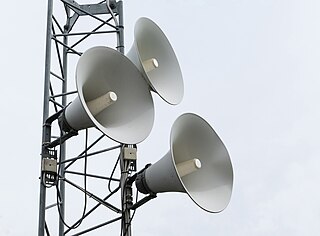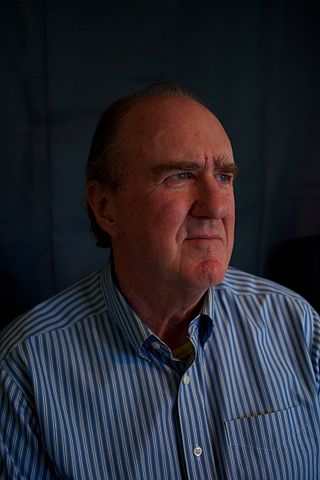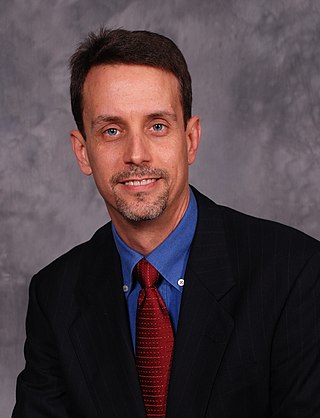
A subwoofer is a loudspeaker designed to reproduce low-pitched audio frequencies, known as bass and sub-bass, that are lower in frequency than those which can be (optimally) generated by a woofer. The typical frequency range that is covered by a subwoofer is about 20–200 Hz for consumer products, below 100 Hz for professional live sound, and below 80 Hz in THX-certified systems. Thus, one or more subwoofers are important for high-quality sound reproduction as they are responsible for the lowest two to three octaves of the ten octaves that are audible. This very low-frequency (VLF) range reproduces the natural fundamental tones of the bass drum, electric bass, double bass, grand piano, contrabassoon, tuba, in addition to thunder, gunshots, explosions, etc.

A loudspeaker is a combination of one or more speaker drivers, an enclosure, and electrical connections. The speaker driver is an electroacoustic transducer that converts an electrical audio signal into a corresponding sound.

A public address system is an electronic system comprising microphones, amplifiers, loudspeakers, and related equipment. It increases the apparent volume (loudness) of a human voice, musical instrument, or other acoustic sound source or recorded sound or music. PA systems are used in any public venue that requires that an announcer, performer, etc. be sufficiently audible at a distance or over a large area. Typical applications include sports stadiums, public transportation vehicles and facilities, and live or recorded music venues and events. A PA system may include multiple microphones or other sound sources, a mixing console to combine and modify multiple sources, and multiple amplifiers and loudspeakers for louder volume or wider distribution.

A sound reinforcement system is the combination of microphones, signal processors, amplifiers, and loudspeakers in enclosures all controlled by a mixing console that makes live or pre-recorded sounds louder and may also distribute those sounds to a larger or more distant audience. In many situations, a sound reinforcement system is also used to enhance or alter the sound of the sources on the stage, typically by using electronic effects, such as reverb, as opposed to simply amplifying the sources unaltered.

A horn loudspeaker is a loudspeaker or loudspeaker element which uses an acoustic horn to increase the overall efficiency of the driving element(s). A common form (right) consists of a compression driver which produces sound waves with a small metal diaphragm vibrated by an electromagnet, attached to a horn, a flaring duct to conduct the sound waves to the open air. Another type is a woofer driver mounted in a loudspeaker enclosure which is divided by internal partitions to form a zigzag flaring duct which functions as a horn; this type is called a folded horn speaker. The horn serves to improve the coupling efficiency between the speaker driver and the air. The horn can be thought of as an "acoustic transformer" that provides impedance matching between the relatively dense diaphragm material and the less-dense air. The result is greater acoustic output power from a given driver.
Klipsch Audio Technologies is an American loudspeaker company based in Indianapolis, Indiana. Founded in Hope, Arkansas, in 1946 as 'Klipsch and Associates' by Paul W. Klipsch, the company produces loudspeaker drivers and enclosures, as well as complete loudspeakers for high-end, high-fidelity sound systems, public address applications, and personal computers.

JBL is an American audio equipment manufacturer headquartered in Los Angeles, California. The company was founded in 1946 by James Bullough Lansing, an American audio engineer and loudspeaker designer. JBL currently serves the home and professional audio markets. Their professional products include live PA systems, studio monitors, and loudspeakers for cinema. Their home products include home audio speakers, waterproof Bluetooth speakers, and high-end car audio. JBL is owned by Harman International, a subsidiary of Samsung Electronics.
Altec Lansing, Inc. is an American audio electronics company founded in 1927. Their primary products are loudspeakers and associated audio electronics for professional, home, automotive and multimedia applications.
Shure Inc. is an audio products corporation headquartered in the USA. It was founded by Sidney N. Shure in Chicago, Illinois, in 1925 as a supplier of radio parts kits. The company became a manufacturer of consumer and professional audio-electronics including microphones, wireless microphone systems, phonograph cartridges, discussion systems, mixers, and digital signal processing. The company also manufactures listening products, including headphones, high-end earphones, and personal monitor systems.

Powered speakers, also known as self-powered speakers and active speakers, are loudspeakers that have built-in amplifiers. Powered speakers are used in a range of settings, including in sound reinforcement systems, both for the main speakers facing the audience and the monitor speakers facing the performers; by DJs performing at dance events and raves; in private homes as part of hi-fi or home cinema audio systems and as computer speakers. They can be connected directly to a mixing console or other low-level audio signal source without the need for an external amplifier. Some active speakers designed for sound reinforcement system use have an onboard mixing console and microphone preamplifier, which enables microphones to be connected directly to the speaker.

Studio monitors are loudspeakers in speaker enclosures specifically designed for professional audio production applications, such as recording studios, filmmaking, television studios, radio studios and project or home studios, where accurate audio reproduction is crucial. Among audio engineers, the term monitor implies that the speaker is designed to produce relatively flat (linear) phase and frequency responses. In other words, it exhibits minimal emphasis or de-emphasis of particular frequencies, the loudspeaker gives an accurate reproduction of the tonal qualities of the source audio, and there will be no relative phase shift of particular frequencies—meaning no distortion in sound-stage perspective for stereo recordings. Beyond stereo sound-stage requirements, a linear phase response helps impulse response remain true to source without encountering "smearing". An unqualified reference to a monitor often refers to a near-field design. This is a speaker small enough to sit on a stand or desk in proximity to the listener, so that most of the sound that the listener hears is coming directly from the speaker, rather than reflecting off walls and ceilings. Monitor speakers may include more than one type of driver or, for monitoring low-frequency sounds, such as bass drum, additional subwoofer cabinets may be used.
Legacy Audio is a manufacturer of high-end audio equipment. The company produces components, passive loudspeakers, and active powered speakers.

Ted Jensen is an American mastering engineer, known for having mastered many recordings, including the Eagles' Hotel California, Green Day's American Idiot and Norah Jones' Come Away with Me.

An audio engineer helps to produce a recording or a live performance, balancing and adjusting sound sources using equalization, dynamics processing and audio effects, mixing, reproduction, and reinforcement of sound. Audio engineers work on the "technical aspect of recording—the placing of microphones, pre-amp knobs, the setting of levels. The physical recording of any project is done by an engineer…"
A coaxial loudspeaker is a loudspeaker system in which the individual driver units radiate sound from the same point or axis. Two general types exist: one is a compact design using two or three speaker drivers, usually in car audio, and the other is a two-way high-power design for professional audio, also known as single-source or dual-concentric loudspeakers. The design is favored for its compactness and behavior as an audio point source.

Cliff Henricksen is a musician, inventor and audio technologist. He is self-taught as a musician with a graduate degree in mechanical engineering at Massachusetts Institute of Technology (MIT). Throughout his career Cliff has found innovative ways to apply engineering basics to electro acoustics and to audio technology as it applies to music and in particular to live music performance. He has invented and engineered a wide variety of technologies and products well known in the world of professional audio. Today he balances work in audio and work as a performing musician.

Charles Emory Hughes II is an American inventor and audio engineer. He is known for his work on loudspeaker design, and the measurement of professional audio sound systems. Hughes first worked for Peavey Electronics designing loudspeakers and horns where he was granted a patent for the Quadratic-Throat Waveguide horn used in concert loudspeakers. He worked for Altec Lansing for two years as chief engineer for the pro audio division and was granted two more patents. In 2021, Hughes was hired by Biamp as principal engineer.
A transmission line loudspeaker is a loudspeaker enclosure design which uses the topology of an acoustic transmission line within the cabinet, compared to the simpler enclosures used by sealed (closed) or ported designs. Instead of reverberating in a fairly simple damped enclosure, sound from the back of the bass speaker is directed into a long damped pathway within the speaker enclosure, which allows far greater control and use of speaker energy and the resulting sound.
Monitor Audio is a British company that specialises in designing and manufacturing loudspeakers and sound systems.
Thomas J. Danley is an American audio engineer, electrical engineer and inventor, the holder of multiple patents for audio transducers, especially high-linearity, high-output professional horn loudspeaker systems. Danley first gained notice in the 1980s with his novel servomotor-driven subwoofer systems used to reproduce very low frequencies in concert tours and theme parks. In 2000 he advanced the implementation of multiple-entry horns in 2000 with several designs led by the SPL-td1, a seven-driver loudspeaker. In 2005, he started a new company, Danley Sound Labs, through which he patented further technologies and produced a wide variety of loudspeaker models based on these technologies.











